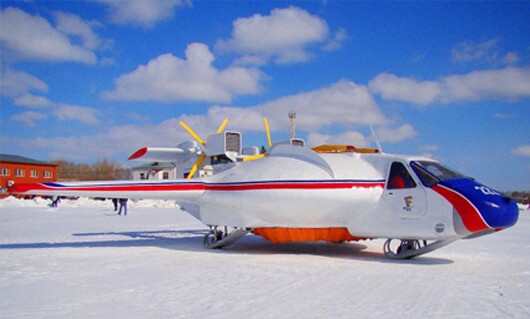As evidenced by ongoing efforts in the Philippines in the wake of Typhoon Haiyan, getting aid and support personnel in and victims out of disaster-stricken areas is a major problem when infrastructure such as runways has been rendered unusable. A new aircraft concept combining features of an airship, plane, helicopter and hovercraft that is being developed as part of the European Commission's Extremely Short Take Off and Landing On any Surface (ESTOLAS) project could help address the problem.
The hybrid ESTOLAS aircraft features a short, squat design with propeller engines mounted at the rear of a disc-shaped main body that houses a rotor like a helicopter's. The aircraft is composed almost entirely of lightweight composite materials and the body and can also be filled with helium to further reduce the aircraft's weight and provide additional lifting power. This would allow it to take off and land at lower speeds on short runways and, if no conventional runways are available, it can use its air-cushioned skirt and wheel-skis to take off and land on any natural surface, such as fields, marshes, water or snow.
The project team is examining four different ESTOLAS sizes, including small, medium, heavy and superheavy with maximum payloads ranging from under 3 tonnes (3.3 tons) to over 400 tonnes (440 tons). Project Coordinator Alexander Gamaleyev of Riga Technical University in Latvia says the superheavy ESTOLAS model would be able to take off and land at distances of 175 m (574 ft), while the small version could do so within just 75 m (246 ft).

Load ratios would also be 1.5 to 2 times higher than conventional jet or propeller planes, with reduced fuel consumption giving the aircraft the ability to deliver cargo anywhere on Earth without refueling. Gamaleyev claims the hybrid aircraft's lower fuel consumption would put it on a par with rail transport in terms of cost, while the reduced CO2 emissions should make it the world's most ecologically efficient form of air transport.
In addition to disaster relief operations, the team envisages the ESTOLAS having a wide variety of applications, including defense, business, tourism and support for the building and operation of remote oil and gas fields. It also has the potential to offer cheaper and more efficient air transport between cities with existing runways and airfields and smaller towns lacking such facilities.

Now that the concept is complete, the team will move onto testing a demonstration model in a wind tube. This will be followed by radio-control flight tests before the 24-month project winds up in April of next year. The team will also examine a number of options to bring the concept to a commercial reality, including licensing the design, seeking venture capital, or establishing joint ventures with industry partners.
The video below shows the design of the ESTOLAS hybrid aircraft.
Source: ESTOLAS Project via New Scientist








